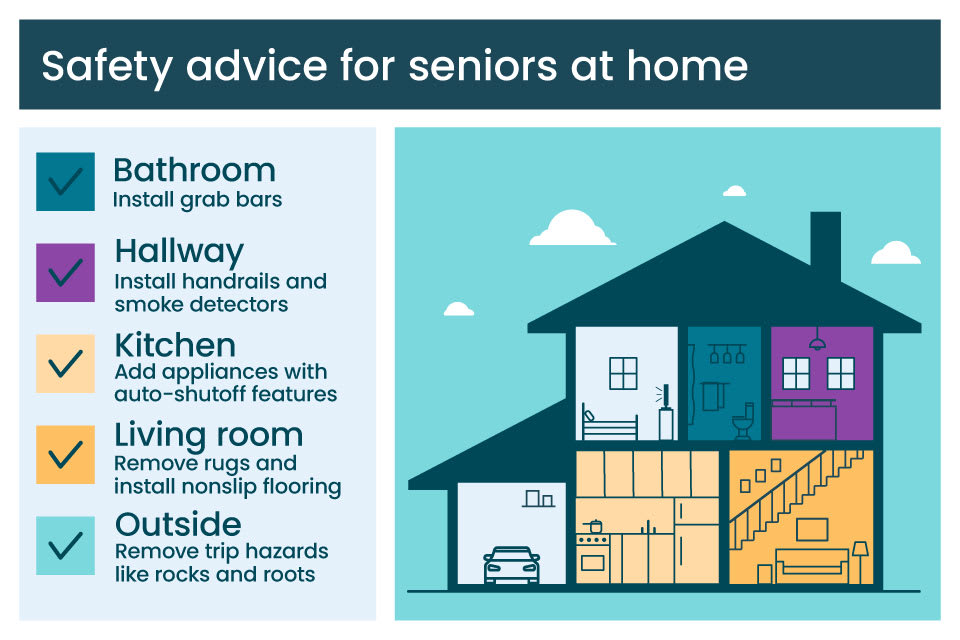Home Safety for Seniors: Essential Tips for Aging at Home

Home safety is essential for seniors who live at home. Reducing the risk of falls is a good place to start, along with preparing for emergencies, enhancing security, and improving accessibility. Safety modifications don’t need to be complicated; a few simple updates can provide important peace of mind for you and your loved one.
Let our care assessment guide you
Our free tool provides options, advice, and next steps based on your unique situation.

Key Takeaways
- Reduce fall risks by removing trip hazards, installing grab bars, and placing nonslip mats in the bathroom.
- Additional home safety tips include preparing for emergencies, updating home security, and making the home more accessible.
- A home safety checklist can help you ensure your senior loved one’s home remains safe and secure.
- A home safety inspection can identify risks you may not have considered and serves as an alternative or supplement to a DIY approach.
1. Fall prevention
The following safety tips can help make your loved one’s home safer while minimizing the chances of a fall:
- Remove tripping hazards. Area rugs, electrical cords, low tables, and ottomans are all risks. Install non-slip flooring and remove or cover all cords and wires. Also, check thresholds: hard-to-see changes in flooring heights contribute to falls. Ask a safety expert about flattening thresholds or adding indoor ramps or handrails.
- Install bathroom grab bars. Grab bars are a great way to prevent falls in the bathroom. You can purchase a grab bar at a hardware store and install it yourself or hire someone to do it.
- Place nonslip mats in the bathroom. Many falls among seniors occur in the bathroom. Nonslip bathmats can help reduce dangerous falls.
- Ensure the home has good lighting. A poorly lit home increases the risk of falls. Install motion-activated bright lighting around the entire home.
- Provide easy seating. Kitchen and shower stools enable seniors to perform activities of daily living such as cooking and bathing in a comfortable seated position.
- Check outdoor spaces. Check the driveway and sidewalk for cracks and be sure there’s a clear path to the mailbox. Remove tripping hazards in the yard, such as rocks and roots.
Falls are the leading cause of fatal and nonfatal injuries in people 65 years of age and older.[01] With more fragile skin and decreased bone density, seniors often face physical challenges recovering from falls. The financial impact of a medically supported recovery can be significant as well.

Let our care assessment guide you
Our free tool provides options, advice, and next steps based on your unique situation.
2. Emergency preparedness
If your senior relative lives alone, it’s important to prepare for worst-case scenarios, such as fires, natural disasters, or medical emergencies. There are several things you can do to ensure your loved one’s home is safe and prepped for an emergency.
- Consider a medical alert device. These devices help keep elderly people safe in their own homes. Wearable devices have easy-access buttons to call for emergency assistance and can be connected to landlines or cellular services. Some models even detect falls automatically.
- Stock an emergency kit. Prepare a kit with essentials such as water, nonperishable food, a flashlight, batteries, a first-aid kit, medications, and important documents. Ensure the kit is easy to access and periodically update it with fresh supplies.
- Have a plan for responding to an emergency. Plan out your response to different likely scenarios. Explain to your loved one what to do in different emergency situations and discuss exit routes.
- Invest in a backup generator. Power outages can be especially dangerous for seniors who live alone. Install a backup power generator to keep lighting and other essential devices functional during a blackout.
3. Security
Security is another important consideration when improving the safety of a senior’s home. Many elderly people live in older homes that may require updates to remain safe and secure. Upgrading your loved one’s home security not only prevents accidents but also helps reduce stress for both you and your elderly relative.
- Use appliances with auto-shutoff features. Appliances, such as stovetops or ovens, that automatically turn off after a set time reduce the risk of fires or other accidents.
- Install high-quality smoke alarms. Choose smoke detectors and carbon monoxide alarms that have a long battery life or smart features that alert both the senior and the caregiver.
- Invest in a security system. A professionally monitored security system with closed circuit TV (CCTV), smart locking doors, and motion detection can deter intruders and help you keep an eye on your loved one.
- Replace surge protectors. Most professionals recommend replacing surge protectors every 3 to 5 years to reduce the risk of fires caused by electrical surges.
People with dementia or Alzheimer’s disease are more likely to be injured from wandering, medication misuse, and other safety threats. If you’re caring for a loved one with dementia, it’s important to take additional security precautions.
4. Accessibility
By starting with simple modifications — such as grab bars, nonslip mats, and accessible light switches and door handles — you may be able to reduce the need for more significant and expensive renovations.
Linda Bohmbach, cofounder and vice president of sales and marketing at Home Healthsmith, a home safety modification company in Portsmouth, Rhode Island, notes that seniors deserve to feel independent in the houses they love and that any home can be made senior-friendly with the right modifications.
“When they look in the mirror, they don’t see someone who’s older,” she says. “They see someone about to go off to war, or a businessman, or a homemaker, so we make the modifications to help them live a full and independent life at home.”
Home safety and accessibility modifications can allow your loved one to age at home comfortably.
- Invest in automatic pill dispensers. Automatic pill dispensers are a simple and safe way to help your loved one manage their medications while maintaining independence.
- Sign up for a medication delivery service. Seniors often fall behind on taking their meds when living alone. Medication delivery services package medications so they’re sorted by date, and ship them to your loved one’s doorstep on a regular schedule.
- Move electrical outlets to accessible locations. Since bending down low can be difficult for some seniors, consider moving lower electrical outlets to waist height.
- Widen doorways. Wider doorways can accommodate seniors with mobility restrictions and those using walkers or wheelchairs.
- Leverage smart home devices. Smart home devices can help set medication reminders, make emergency calls, and activate lighting or appliances by using voice commands.
- Install a stairlift. If your loved one’s home is more than one floor, consider a stairlift to accommodate any mobility restrictions.
- Replace standard door handles with lever handles. Lever door handles are easier to operate than traditional knobs, especially for those who have arthritis or limited grip strength.
5. Home safety checklist
A home safety checklist can help you keep track of the safety tips covered above. Review this checklist periodically to ensure your senior loved one’s home remains safe and secure.

Talk with a Senior Living Advisor
Our advisors help 300,000 families each year find the right senior care for their loved ones.
Schedule a home safety inspection
A home safety inspection is a comprehensive evaluation and elimination of potential hazards. A certified home safety specialist, such as an occupational therapist, can make recommendations to help keep your loved one safe in their home. Often, elderly people don’t realize their home is unsafe and don’t feel the need to make changes, says Bohmbach.
A thorough home safety inspection should include the following:
- An assessment of “red zones,” such as bathrooms, kitchens, staircases, porches, and outdoor steps
- A search for existing fall hazards
- A check for fire hazards and working alarms
- Information about door widening, stair lifts, wheelchair ramps, and other appropriate accessibility or safety additions
- A comprehensive proposal, including pricing
How to help a senior age in place safely
While accessibility devices and routine safety checks can help with home safety, assistance with health care and activities of daily living may become necessary as people age. In-home care can offer a range of benefits. In-home caregivers can provide companionship, conduct regular check-ins if family members don’t live nearby, run errands, and provide more supportive services as needed.
If your loved one needs extra support at home, A Place for Mom’s Senior Living Advisors can help you explore home care and senior living options (including independent living, assisted living, memory care, and nursing homes) that are designed to support safety and well-being.
Families also ask
Does insurance cover home safety assessments for elderly patients?
While traditional health insurance doesn’t typically cover home safety assessments, your loved one’s policy may cover one if it’s considered medically necessary by a doctor or an occupational therapist. Medicare Part B may also cover home safety assessments.
How can you tell if an elderly person is deteriorating?
Some signs that your loved one may be declining and need additional help include:
- Mismanaged medications
- Poor hygiene
- A messy house
- Mismanaged finances
- Unsafe driving
- Unhealthy eating habits
- Weight loss
- Changes in appetite
- Unexplained burns, bruises, and cuts
- Forgetfulness or confusion
How much does a home safety assessment cost?
A home safety assessment may cost between $50 and $200, depending on the location and size of the home.
What’s a safe bed height for an elderly person?
A safe bed height for elderly people is generally between 18 inches and 23 inches, around the height of a chair. However, an occupational or physical therapist can provide more personalized recommendations to accommodate abilities and ensure comfort and safety.
What are the most common home hazards for elderly people?
Some of the most common home hazards for elderly people include:
- Cluttered floors
- Stairs
- Bathtubs and showers
- Poor lighting
- Loose rugs
- Uneven or slippery flooring
Centers for Disease Control and Prevention. (2024, October 28). Older Adult Falls Data.
Home care in all states
The information contained on this page is for informational purposes only and is not intended to constitute medical, legal or financial advice or create a professional relationship between A Place for Mom and the reader. Always seek the advice of your health care provider, attorney or financial advisor with respect to any particular matter, and do not act or refrain from acting on the basis of anything you have read on this site. Links to third-party websites are only for the convenience of the reader; A Place for Mom does not endorse the contents of the third-party sites.
Make the best senior care decision
Make the best senior care decision
